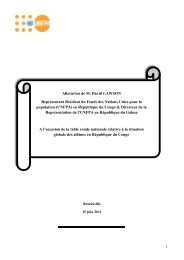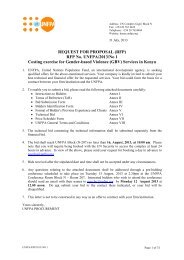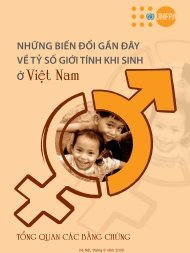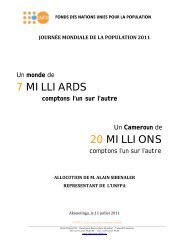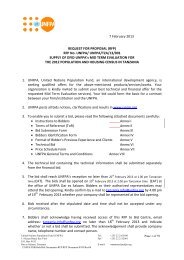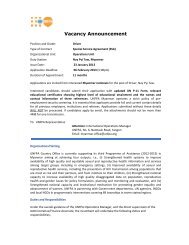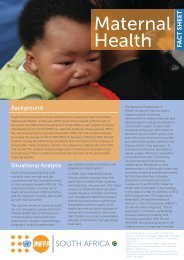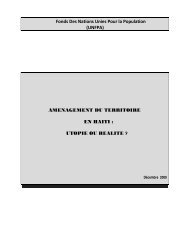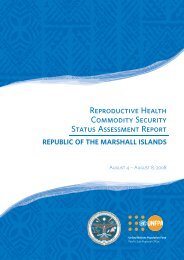A reproductive health needs assessment in Myanmar
A reproductive health needs assessment in Myanmar
A reproductive health needs assessment in Myanmar
Create successful ePaper yourself
Turn your PDF publications into a flip-book with our unique Google optimized e-Paper software.
A Reproductive Health Needs Assessment <strong>in</strong> <strong>Myanmar</strong><br />
Reproductive Tract Infections<br />
The term “<strong>reproductive</strong> tract <strong>in</strong>fection” (RTI) is used to refer to a variety of <strong>in</strong>fections that<br />
may occur <strong>in</strong> men and women. It <strong>in</strong>cludes the numerous sexually transmitted diseases<br />
(STDs), as well as iatrogenic and endogenous <strong>in</strong>fections of the <strong>reproductive</strong> tract. The latter<br />
are most common among women and either result from genital tract procedures, such as IUD<br />
<strong>in</strong>sertion and <strong>in</strong>duced abortion (iatrogenic <strong>in</strong>fection), or the disturbance of vag<strong>in</strong>al ecology,<br />
with an associated overgrowth of organisms normally present <strong>in</strong> the vag<strong>in</strong>a (endogenous<br />
<strong>in</strong>fection). Bacterial vag<strong>in</strong>osis and candida (yeast) <strong>in</strong>fection are the common endogenous<br />
RTIs and together are responsible for the majority of vag<strong>in</strong>al discharge symptoms among<br />
women. STDs <strong>in</strong>clude genital ulcerative diseases (such as syphilis, chancroid, and herpes),<br />
gonorrhoea and chlamydia (the most common causes of urethral and cervical <strong>in</strong>fection), and<br />
numerous viral <strong>in</strong>fections. Viral pathogens <strong>in</strong>clude Human Papilloma Virus (HPV), which<br />
has been associated with the development of several genital tract cancers, and Human<br />
Immunodeficiency Virus (HIV), the cause of Acquired Immune Deficiency Syndrome<br />
(AIDS).<br />
Given the serious and well-described epidemic of HIV that emerged <strong>in</strong> neighbour<strong>in</strong>g<br />
Thailand <strong>in</strong> 1989, great concern has been raised regard<strong>in</strong>g the potential spread of HIV/AIDS<br />
with<strong>in</strong> <strong>Myanmar</strong> over the past several years. Relatively less attention has been directed<br />
toward the broader category of STDs, although a vertical programme for the control of STDs<br />
has existed for many years. Endogenous RTIs have received very little attention and the need<br />
to address this category of <strong>in</strong>fection has only been brought <strong>in</strong>to focus by recent attempts to<br />
expand and <strong>in</strong>tegrate the provision of <strong>reproductive</strong> <strong>health</strong> services. As <strong>in</strong> most other<br />
countries, iatrogenic <strong>in</strong>fections have rema<strong>in</strong>ed almost entirely undocumented.<br />
OVERVIEW OF RTI PREVALENCE<br />
Ironically, the best prevalence data currently available concern the newest RTI pathogen,<br />
HIV. A national sent<strong>in</strong>el surveillance programme for HIV <strong>in</strong>fection was established <strong>in</strong><br />
March 1992. This programme <strong>in</strong>volves the semi-annual (March and September) collection of<br />
anonymous, unl<strong>in</strong>ked blood samples from a number of “sent<strong>in</strong>el” groups. The sent<strong>in</strong>el<br />
groups are designed to <strong>in</strong>clude a number of “at risk” groups (e.g., STD patients, sex workers,<br />
and <strong>in</strong>jection drug users), as well as several groups more <strong>in</strong>dicative of prevalence among the<br />
general population (e.g., pregnant women, blood donors, and new military recruits). Results<br />
from the September 1997 round of surveillance screen<strong>in</strong>g are summarised <strong>in</strong> Table 10 (March<br />
1998 results were not available at the time of this report). Review of the site specific data<br />
reveal a considerable amount of geographic variation <strong>in</strong> the prevalence of HIV among the<br />
various sent<strong>in</strong>el populations, with rates generally higher <strong>in</strong> the eastern States and Divisions<br />
border<strong>in</strong>g Thailand, Laos, and southwestern Ch<strong>in</strong>a (Yunnan) (DOH 1997). A review of<br />
temporal trends (Table 11) <strong>in</strong>dicates that rates of HIV <strong>in</strong>fection are extremely high among<br />
<strong>in</strong>jection drug users and are generally <strong>in</strong>creas<strong>in</strong>g among sex workers and STD clients (male<br />
and female). Of particular concern is the steady rise <strong>in</strong> seroprevalence rates among the<br />
“lower risk” sent<strong>in</strong>el groups (blood donors, pregnant women, and military recruits). This<br />
suggests that current efforts to reach “high risk” populations are <strong>in</strong>effective and the epidemic<br />
is spread<strong>in</strong>g further with<strong>in</strong> the general population. The most recent HIV prevalence rates<br />
among antenatal clients range between 0.0 per cent <strong>in</strong> Yangon and Bago and 5.1 per cent <strong>in</strong><br />
Kawthaung on the <strong>Myanmar</strong>-Thailand border.<br />
39




